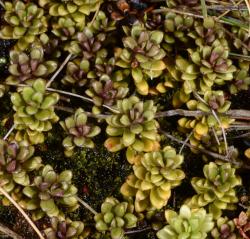- Taxon
- Gallery
- = Forstera bidwillii Hook.f., Bot. Antarct. Voy. II. (Fl. Nov.-Zel.) Part I, 155 (1853)
- = Forstera truncatella Colenso, Trans. & Proc. New Zealand Inst. 20: 196 (1887 [1888])
- = Forstera major Colenso, Trans. & Proc. New Zealand Inst. 31: 272 (1899)
- = Forstera bidwillii var. densifolia Mildbr., Bot. Gaz. 46: 25 (1908)
Plants decumbent from short- to long-creeping stems and rooting from old leaf axils, vegetative axis (35–)90–430(–760) mm long, leafy terminus of stem erect. Stem 1.2–3.0 mm in diameter when fresh, 1.4–3.6 mm in diameter when dry, dark purple or purple-brown, branches 0–4(–5) per plant, bare of leaves for c. (23–)70–200 mm. Leafy parts of the branches 12–150 mm long, shoot with leaves 10–18 mm in diameter when fresh (11–14–28 mm wide when pressed. Leaves imbricate to spaced so as to leave the stem easily visible; most of leaf patent; 5.0–16(–18.3) mm long, (1.6–)2.2–4.9(–5.2) mm wide, 0.7–2.3 mm wide at leafbase, (170–)250–750(–830) µm thick; elliptical to obovate, widest at midleaf or above midleaf (apex to widest point 0.24–0.5 x leaf length), apex bluntly acute or obtuse, sometimes apiculate; leaves plane; green adaxially and abaxially without tinting or with a slight crimson tinting evenly present on the leaf surface or present only in the proximal part of the leaf, or over the median stripe, or forming an intramarginal band; upper surface not glossy; median stripe indistinct on lower leaf surface, visible only by absence of stomata; stomata forming a zone on lower leaf surface either side of median stripe, not extending to the margin; leaf margin entire, with an inconspicuous hyaline border c. 0.05–0.15 mm wide, usually only noticeable near the apex; a conspicuous or inconspicuous raised hydathode on upper leaf surface near the apex just below the hyaline border, red-brown or crimson.
Flowering stems 1–3 per plant. Peduncle crimson, pale pink, pale yellow, or green at the base becoming tinted crimson distally (17–)20–150 mm long, 0.40–0.50 mm in diameter, enlarging to c. 0.7 mm diameter below the bracts. Flowers 1–2(–4) per peduncle. Bract at base of pedicel 3.3–5.0 mm long, 0.9–2.0 mm wide, margins with hyaline hairs. Pedicel 0.5–6.0 mm long, green, pale yellow, or crimson. Bracteoles (3.1–)3.9–4.2 mm long, 0.7–1.0 mm wide, margins with hyaline hairs, occasionally glabrous. Ovary 2.0–3.7 mm long, green or tinted slightly crimson. Sepals 6 per flower, subequal in size but sometimes 4 forming 2 adjacent pairs, 2.3–4.3 mm long, 1.0–1.7 mm wide, margins with hyaline hairs 190–400 µm long. Corolla 5.0–8.5 mm long, lobes 6 per flower, equal, 4.0–6.9 mm long, 2.0–4.1 mm wide, apices obtuse, margins very finely serrate; white, usually with crimson speckles in the lower half of lobes, mainly visible on the inner surface, a few sometimes visible on the outer surface; corolla sinus transparent; a pair of vertical spurs on each corolla lobe at the level of the sinus, c. 0.6 mm long, free for half their length and pointing distally, pale creamy yellow to dark yellow, sometimes distinctly papillose. Nectaries flattened narrow cones, apices acute or bifid, pale yellow to pale green, 1.2–1.8 mm long. Gynostemium 2.7–5.0 mm long, white, stigmas 2,0.7–1.2 mm long at female phase, unlobed to deeply bilobed, then appearing 4 per flower. Anthers 1.0–1.2 mm long, walls mid to dark purple. Capsule 5.3–10.5 mm long. Seeds (1.2–)1.3–1.7 mm long.
[Reproduced from Glenny (2010, New Zealand J. Bot. 47: 285–315) with permission from The Royal Society of New Zealand.]
Flowering: Dec.–Feb.; Fruiting: Jan.–Mar.




